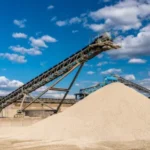Acidizing Additives – Critical Role of Acid in Oilfield Stimulation
Dwindling flow rates from a once-productive well? It’s a common headache in the oil and gas game. As reservoirs mature and permeability drops, getting those hydrocarbons out becomes a real challenge. That’s where well stimulation steps in, basically giving your well a much-needed boost. And at the heart of many stimulation jobs is Acidizing. Think of it as a targeted cleanup, dissolving the blockages that are choking your production in addition to acidizing additives..
We’re talking about dissolving carbonates, clearing scale, and opening up those flow paths. It’s a critical tool, and getting the right acid blend with the right additives is key to maximizing results. At Sunita USA, we understand this. Therefore, we provide high-quality acidizing additives tailored to your specific reservoir conditions to help you bring those wells back to life.
What is Acidizing?
Acidizing in well completion refers to a process where a reactive acid solution is pumped into a wellbore to dissolve minerals within the surrounding rock formation that restrict flow.
The basic chemistry involves acids, like hydrochloric (HCl), reacting with carbonate rocks (limestone, dolomite). This reaction forms soluble salts, water and carbon dioxide, effectively eating away at the rock.
Now, we have two main approaches:
- Matrix acidizing is where we inject acid at pressures below the rock’s fracturing point, focusing on dissolving the existing pore spaces near the wellbore to improve permeability. This widens the existing channels.
- Fracture acidizing or acid fracturing is where we pump acid at high pressure to create new fractures in the rock, essentially creating new pathways for oil and gas to flow. The acid etches these fractures, keeping them open.
Types of Acids Used in Oilfield Stimulation
When it comes to acidizing, the choice of acid is crucial. We’re not using just one type; it’s a tailored approach depending on the formation.
- Hydrochloric Acid (HCl): This is the workhorse of acidizing. It’s highly effective at dissolving carbonate formations like limestone and dolomite. However, it’s also highly corrosive, and its reaction rate is rapid, which can limit its penetration depth.
- Hydrofluoric Acid (HF): When dealing with sandstone or silica-rich formations, HF is essential. It dissolves silicates, which HCl can’t touch. However, HF is extremely hazardous, requiring careful handling and specialized equipment.
- Organic Acids (Acetic, Formic): These are milder acids, useful when we need a slower, more controlled reaction. They’re often preferred in high-temperature reservoirs or when corrosion is a major concern. They provide a slower reactivity than the stronger mineral acids.
- Mud Acid: This is a blend of HCl and HF, designed to remove drilling mud damage. Drilling mud can plug pore spaces, and mud acid effectively dissolves both carbonate and silicate components of the mud.
It is important to use the correct acid combinations by in-depth analysis of reservoir lithology, temperature and the type of formation damage. This choice has a direct effect on the production capacity of the well.
What are Acidizing Additives?
Acidizing additives are chemical compounds introduced into acid solutions to enhance treatment effectiveness and mitigate potential issues. They modify the acid’s properties, controlling reaction rates, preventing corrosion, and improving fluid compatibility.
Corrosion inhibitors protect the wellbore tubular from acid attack. Surfactants reduce surface tension, preventing emulsions and improving acid contact. Iron control agents prevent the precipitation of iron compounds, which can plug pores and so on.
Types of Acidizing Additives
Alright, let’s dive into the world of acidizing additives. These aren’t just afterthoughts; they’re essential for tailoring acid treatments to specific well conditions and maximizing their effectiveness.
1. Gelling Agents
These are polymers that increase the viscosity of the acid, creating a thicker fluid. This is crucial for fracture acidizing, where you need to create and maintain fracture width. Gelled acids slow down the reaction rate and allow for deeper penetration into the formation. Think of it as creating a more powerful, controlled stream of acid.
2. Corrosion Inhibitors
Acids are inherently corrosive, which can damage wellbore tubulars and equipment. Corrosion inhibitors form a protective film on metal surfaces, minimizing acid attack. This is vital for maintaining the integrity of the well and preventing costly repairs. They are essential to any acidizing treatment.
3. Iron Control
Reservoir fluids often contain iron, which can precipitate out of solution when exposed to acid, forming iron compounds that plug pore spaces. Iron control agents, like chelating agents, prevent this precipitation, ensuring that the created flow paths remain open.
4. Scale Inhibitors
Scale deposits, such as calcium carbonate or barium sulfate, can restrict flow in wells. Scale inhibitors prevent these deposits from forming or dissolve existing scale, maintaining permeability and production.
5. Surfactants
These reduce the surface tension between the acid and the rock, allowing for better wetting and penetration. They also help to prevent the formation of emulsions, which can reduce the effectiveness of the acid. Surfactants help the acid make better contact with the rock.
6. Non-emulsifiers
These additives specifically target the prevention of emulsion formation. Emulsions are a mix of oil and water that are very difficult to remove from the formation. Non-emulsifiers help to keep the oil and water separate, so that the acid can do its job.
7. Anti-sludge agents
These additives prevent the formation of sludge, which is a byproduct of the acid reaction with some crude oils. Sludge can plug the formation and reduce production. Anti-sludge agents keep the byproducts in a liquid state, so that they can be produced from the well.
8. Diverting Agents
These are used to ensure that the acid is distributed evenly across the target formation. They can be solids, like benzoic acid flakes, or fluids that temporarily block high-permeability zones, forcing the acid to treat lower-permeability zones. This ensures a more uniform stimulation treatment. They are very important in long horizontal wells, or wells with multiple pay zones.
Why is Acidizing Important?
Acidizing is a crucial tool for maximizing well productivity. Here’s a breakdown of its importance:
Increased Production:
Acidizing directly tackles the issue of restricted flow by dissolving rock and creating flow channels. This allows hydrocarbons to move more freely towards the wellbore which significantly increases production.
Improved Permeability:
Imagine a sponge with clogged pores. Acidizing acts like a powerful cleaner, opening up those pores and creating new pathways. This enhanced permeability allows fluids to flow through the reservoir with less resistance.
Enhanced Reservoir Connectivity:
Reservoirs often contain isolated pockets of hydrocarbons. Acidizing can connect these isolated pore spaces, effectively expanding the drainage area and allowing for more efficient recovery.
Extended Well Life:
Over time, wells can experience declining production due to formation damage or natural depletion. Acidizing can revitalize aging wells by removing blockages and restoring permeability, effectively extending their productive lifespan.
Overcoming Formation Damage:
Drilling and production operations can introduce debris and other materials that block pore spaces and restrict flow. Acidizing effectively removes these blockages, restoring the reservoir’s natural permeability. This means that issues like scale buildup, or drilling mud invasion can be mitigated.
In essence, acidizing is a vital technique for optimizing well performance and maximizing hydrocarbon recovery. It addresses key challenges related to permeability, connectivity, and formation damage, leading to increased production and extended well life.
So, why is acidizing such a vital tool in the oil and gas industry? Simply put, it’s about unlocking the potential of your reservoir.
One of the biggest wins is increased production. By dissolving rock and creating flow channels, acidizing dramatically boosts hydrocarbon flow, leading to higher production rates.
Sunita USA’s Acidizing Additives Solutions:
When it comes to optimizing acidizing treatments, Sunita USA stands out as a premier manufacturer of high-quality additives. We understand that effective acidizing hinges on reliable chemical solutions, which is why we’ve dedicated ourselves to producing top-tier products.
Sunita USA’s acidizing additives are formulated to address the diverse challenges encountered in well stimulation. Our product line encompasses a comprehensive range, including robust corrosion inhibitors, efficient iron control agents, powerful surfactants, and effective diverting agents, among others. Each product is crafted to ensure consistent performance and maximize well productivity.
We prioritize quality and reliability, ensuring that our additives deliver predictable results in demanding oilfield environments. Our commitment to innovation and customer satisfaction drives us to continuously refine our formulations and provide tailored solutions. When you choose Sunita USA, you’re choosing additives designed for optimal performance and long-term well success.





